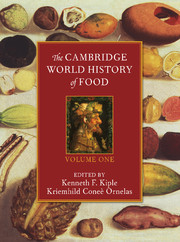Book contents
- Frontmatter
- Introduction
- Part I Determining What Our Ancestors Ate
- Part II Staple Foods: Domesticated Plants and Animals
- Part III Dietary Liquids
- Part IV The Nutrients – Deficiencies, Surfeits, and Food-Related Disorders
- IV.A Vitamins
- IV.B Minerals
- IV.C Proteins, Fats, and Essential Fatty Acids
- IV.D Deficiency Diseases
- IV.E Food-Related Disorders
- IV.E.1 Anorexia Nervosa
- IV.E.2 Celiac Disease
- IV.E.3 Food Allergies
- IV.E.4 Food-Borne Infection
- IV.E.5 Food Sensitivities: Allergies and Intolerances
- IV.E.6 Lactose Intolerance
- IV.E.7 Obesity
- IV.F Diet and Chronic Disease
- References
IV.E.2 - Celiac Disease
from IV.E - Food-Related Disorders
Published online by Cambridge University Press: 28 March 2008
- Frontmatter
- Introduction
- Part I Determining What Our Ancestors Ate
- Part II Staple Foods: Domesticated Plants and Animals
- Part III Dietary Liquids
- Part IV The Nutrients – Deficiencies, Surfeits, and Food-Related Disorders
- IV.A Vitamins
- IV.B Minerals
- IV.C Proteins, Fats, and Essential Fatty Acids
- IV.D Deficiency Diseases
- IV.E Food-Related Disorders
- IV.E.1 Anorexia Nervosa
- IV.E.2 Celiac Disease
- IV.E.3 Food Allergies
- IV.E.4 Food-Borne Infection
- IV.E.5 Food Sensitivities: Allergies and Intolerances
- IV.E.6 Lactose Intolerance
- IV.E.7 Obesity
- IV.F Diet and Chronic Disease
- References
Summary
Historical Perspective
Celiac disease has been recognized for centuries (Dowd and Walker-Smith 1974) by physicians aware of its major symptoms of diarrhea and gastrointestinal distress accompanied by a wasting away in adults and a failure to grow in children. The Greek physician Aretaeus (first century A.D.) called the condition coeliac diathesis – coeliac deriving from the Greek word koeliakos, or abdominal cavity. The British physician Samuel Gee provided what is generally considered the first modern, detailed description of the condition, which he termed the coeliac affection in deference to Aretaeus, in a lecture presented at St. Bartholomew’s Hospital in London (Gee 1888). At present, celiac disease (or, especially in Britain, coeliac disease) is the most commonly used term for the condition, although various others may be encountered, including celiac syndrome, celiac sprue, nontropical sprue, and glutensensitive enteropathy.
There were perceptions, certainly since Gee’s time, that celiac disease was a consequence of, or at least affected by, diet. Gee (1888: 20) noted that “[a]child, who was fed upon a quart of the best Dutch mussels daily, throve wonderfully, but relapsed when the season for mussels was over.” Such associations with diet led to wide-ranging dietary prescriptions and proscriptions (Haas 1924; Sheldon 1955; Weijers, Van de Kamer, and Dicke 1957; Anderson 1992). Some physicians recommended exclusion of fats – others, exclusion of complex carbohydrates. At times, so many restrictions were applied simultaneously that it became impossible to maintain a satisfactory intake of calories.
- Type
- Chapter
- Information
- The Cambridge World History of Food , pp. 1008 - 1022Publisher: Cambridge University PressPrint publication year: 2000
References
- 3
- Cited by

